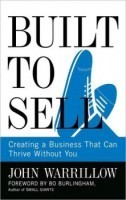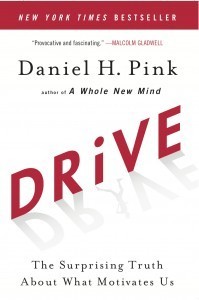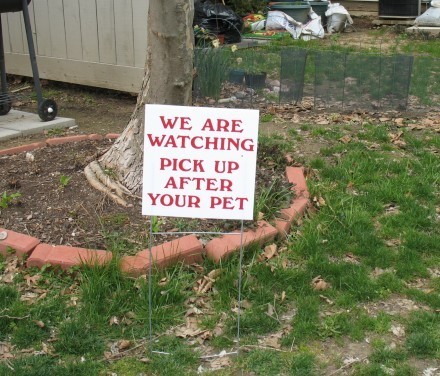Daniel H. Pink's Blog, page 16
May 3, 2011
Can signs turn (road) rage into rapture?
Dirk Van Staeyen of Belgium sends these examples of emotionally intelligent signage along with a brief explanation:
"I drove home from holiday today and came across these signs (in the Netherlands) on a stretch of highway where roadworks were in progress. These smiley signs are placed 1 kilometer apart from each other, each time showing a happier face as you near the end of the works. They didn't get me to the end of the roadworks any faster but they sure brought a smile to my face. It was the first time I saw them but apparently they're also frequently used in Germany and Austria with a similar, positive response from drivers."
(Note: For those who need to brush up on your Dutch, "Nog" means essentially "still" or "more.")


May 2, 2011
Will we now hear two phrases from the past?
History doesn't repeat itself, but people do. And since people use language, I wonder if , Americans will be hearing two phrases from recent history that now have new relevance.
1. Peace dividend. Remember 20 years ago when the Cold War ended? Now that that Soviet Union had been vanquished, all that money we were spending on defense would be less necessary and we could redirect our budgets toward domestic priorities. It was a nice sentiment, but it never really materialized. Perhaps now is the moment. After several trillion dollars of spending on wars in Iraq and Afghanistan, and after making the entire world safer, maybe Americans will get a 21st century peace dividend — and use the funds at home to tackle education, infrastructure, and the national debt.
2. Morning in America. Two weeks ago, the New York Times reported that 70% of Americans believed that the country was heading in the wrong direction. Bin Laden's demise will no doubt improve that number in the short term. But in the long-term, it might reboot American confidence more deeply — and as a result, deliver a low-cost economic stimulus. Remember: At this point in Ronald Reagan's term, the US was on the ropes. But after taking on that era's bear in the woods and seeing the economy tick upward, a year later it was "morning again in America."
April 29, 2011
John Warrillow's 3 habits of highly successful entrepreneurs
 John Warrillow has been studying entrepreneurs for fifteen years. First as the producer of a syndicated radio show, then as the founder of a research company that surveyed ten thousand business owners each year, and now as an angel investor and columnist for both Inc.com and CBS NEWS.
John Warrillow has been studying entrepreneurs for fifteen years. First as the producer of a syndicated radio show, then as the founder of a research company that surveyed ten thousand business owners each year, and now as an angel investor and columnist for both Inc.com and CBS NEWS.
As it happens, he has a terrific new book out this week (buy it here) — so I asked him to describe what he thought are the three most important habits of highly successful entrepreneurs.
Here's John:
1. Resourceful
When they couldn't get a loan to start a yoghurt store, Aaron and Michael Serruya signed a two-month lease on a kiosk. They learned what flavors sold best, how to merchandise and market while pocketing the profits. With the money they saved that summer, they established a real store, called it Yogen Fruz, and it would become the largest yogurt chain in the world. What the Serruya brothers did – and what I've seen most successful entrepreneurs make a habit of – is improvise. Saras Sarasvathy, a professor at the Darden School of Business, has discovered that entrepreneurs think more like an "Iron Chef" than a methodical planner. They size up the resources they have available and develop the best outcome.
2. Competitive
Entrepreneurs look for ways to measure themselves against their peers. That's why the Inc 500, the list of the fastest growing businesses in the U.S., is such an amazing franchise. It's also why groups like Entrepreneur's Organization ($1 million + in sales to join) and Tiger 21 ($10 million + in liquid assets to apply) go out of their way to communicate their membership qualifications.
3. Action Oriented
I, along with forty other entrepreneurs at a workshop, took Kathy Kolbe's test which measures you on the dominance of four personality traits. A handful of us were "Fact Finders" (seek knowledge before acting), one or two were long on "Follow Through" (good at finishing tasks) but virtually everyone of us were "Quick Start" (start lots of things) which just goes to show that entrepreneurs have a tendency for perpetual motion. They are happiest when bushwhacking — trying lots of things to see what works.
April 25, 2011
Entrepreneurs are Iron Chefs, Managers are Swedish Chefs
 In this February Inc. Magazine article, which I finally got to this weekend, The University of Virginia's Saras Sarasvathy talks about research she's done into the thinking styles of accomplished entrepreneurs.
In this February Inc. Magazine article, which I finally got to this weekend, The University of Virginia's Saras Sarasvathy talks about research she's done into the thinking styles of accomplished entrepreneurs.
The whole piece is worth reading, but I was especially intrigued by her flavorful distinction between entrepreneurial thinking and managerial thinking:
"Sarasvathy likes to compare expert entrepreneurs to Iron Chefs: at their best when presented with an assortment of motley ingredients and challenged to whip up whatever dish expediency and imagination suggest. Corporate leaders, by contrast, decide they are going to make Swedish meatballs. They then proceed to shop, measure, mix, and cook Swedish meatballs in the most efficient, cost-effective manner possible."
Are you an Iron Chef or a Swedish Chef? Or is this difference just a misleading stew?
April 12, 2011
1 new edition, 1 cool project, 52 free books
 To celebrate this month's publication of the updated, expanded edition of Drive (buy it here, here, or here), we're launching a cool new project.
To celebrate this month's publication of the updated, expanded edition of Drive (buy it here, here, or here), we're launching a cool new project.
It's called "Office Hours" — and here's how it works:
Once a month, I'll get on the phone — accompanied by an awesome guest — and open the line to take your questions about business, work, or life in general. I'll record the call. Then I'll post the recording on the Internet. It's one part college professor, opening the virtual office door — another part radio show, providing listeners an hour of informative entertainment.
Think of it as "Car Talk" for the human engine.
Our first episode of "Office Hours" will be Thursday April 21 at 1pm, EDT. Our special guest will be Seth Godin . And you're invited both to listen in and to ask a question.
(Note: Subscribers to the free Pink Newsletter received this invitation last week — so if you're not signed up, you're missing offers like these.)
Alas, because this is a complicated undertaking, and because we want to avoid a technological shipwreck on our maiden voyage, we needed to limit the participants to 500 people (a number we later expanded to 1,000.)
And the way we decided to keep the size reasonable was as follows: The only people eligible to participate in this first episode are those: a) who buy the paperback edition of the book before April 15; or b) who have already purchased the book in some other form.
It's our way of saying thank-you for your support. And while it's not ideal, it's the fairest way we've come up with to keep the audience manageable and give a tiny benefit to Drive supporters.
Newsletter subscribers have filled up most of the spaces — but as of this morning, we still have about 80 places left.
So if you're interested in participating, just go to this brief online form, include your name and email address, and upload your receipt for your purchase of Drive. (If you bought the hardcover, audio, or ebook, and no longer have the receipt, just upload a one-sentence Word, Pages, or PDF document saying that. We'll trust you.)
Once we've filled the remaining spaces, everyone signed up will receive a special call-in number to listen to the first broadcast — along with instructions for "raising your hand" to ask a question of me or Seth.
But wait! It gets even better! Fifty-two lucky registrants, selected in a random drawing, will also receive a free copy of Seth's terrific new book, Poke the Box.
As we work out the techno-kinks in later episodes, we'll do our best to let in even more people. But the first attempt has to be a bit exclusive. So if you want to play, sign up today.
April 11, 2011
Emotionally intelligent signage and your dog
Sara Davis sends the following photo, which she took at her apartment complex in Cincinnati. The sign "left me angry," she says, and "feels invasive and generally icky."
It reminded me of another sign — designed to encourage precisely the same behavior but by encouraging empathy — that I snapped in my neighborhood in Washington, DC.
Is one sign more effective than the other? Or do they simply accomplish the same result by different means?
April 7, 2011
Emotionally intelligent signage on a box
Devotees of emotionally intelligent signage (yes, both of you) will recall that the original definition of the term hinged largely on empathy. Emotionally intelligent signs were those that either:
a) empathize with the viewer and thereby improve the experience of a space (Example: A sign in a seemingly crowded museum cafeteria that reads, "Don't worry. This line moves quickly."); or
b) encourage empathy on the part of the viewer in order to gain compliance with a rule. (Ex: The sign at the Vietnam Veterans Memorial that reads, "Honor those served. Please stay off the grass.")
But can signage and other graphics nudge us to empathize not just with our fellow human beings, but also with inanimate objects?
Perhaps. Check out this photo from Todd Boudreaux. Do you think people are more likely to handle this box properly than one with, say, a notice reading "This Side Up"?
April 4, 2011
3 tricks for solving problems faster and better
 Ever come up with a great idea for someone else, but find yourself stymied by your own problem?
Ever come up with a great idea for someone else, but find yourself stymied by your own problem?
Recent research by Evan Polman of NYU and Kyle J. Emich of Cornell may shed some light on why. In three sets of experiments, they found that when people solved problems on behalf of others, they produced faster and more creative solutions than they did when they solved the same problems for themselves.
In the first experiment, Polman and Emich asked participants either to draw an alien for a story they were going to write themselves or for someone else's story. The aliens people sketched for others were more creative than the ones they drew for themselves.
In the second study, participants were asked to come up with gift ideas for themselves, for someone close to them, or for someone far away. The result: The more distant the recipient, the more creative the gift.
And in the third study, participants had to solve the following problem:
A prisoner was attempting to escape from a tower. He found a rope in his cell that was half as long enough to permit him to reach the ground safely. He divided the rope in half, tied the two parts together, and escaped. How could he have done this?
Subjects were more likely to come up with the answer on behalf of another person than for themselves; the farther away the other person was imagined to be, the more likely the participants were to come up with the correct answer.
Polman and Emich say the principle at work is something called "construal-level theory," which in simple terms means that we think in more abstract terms about distant problems (or problems belonging to distant people) — and thinking at a more abstract level produces more creative solutions.
So given that we're often more creative solving someone else's problems, what can we do to more effectively solve our own? Here are three ideas:
1. Trade problems with someone. When you get stuck, stop hammering away at the problem and find a colleague to swap with.
2. Solve problems on behalf of someone else. Create some psychological distance from your project by pretending that you're doing it on behalf of someone else. Use your imagination here: the "other person" could be the woman across the hall, a relative, or a stranger halfway across the world. The farther away, the better.
3. Put some distance between yourself and your project. Writers know something magical happens when you put your manuscript away in a drawer. When you come back to it a week or a month or six months later, you have a fresher, more creative perspective on the work. When you can, build some slack into your deadlines and try putting your work out of sight for as long as you can manage.
Have you tried this approach? Has anyone set up a website to allow people to swap problems? (Seems like a promising business.) And how the heck did the prisoner escape? If you've got answers, respond in the Comments section.
March 28, 2011
Travel Tip #11 – The Hidden Benefits of Mickey D's
PREVIOUS TIPS:
Tip #1 — Never get sick again
Tip #2 — The magic of earplugs
Tip #3 — Four road food rules of thumb
Tip #4 — The rule of HAHU
Tip #5 — More hygiene!
Tip #6 — Staying connected
Tip #7 — Zipping through security lines
Tip #8 — One thing you should never do in a hotel room
Tip #9 — The secret(s) to beating jet lag
Tip #10 — The first thing you should buy
March 24, 2011
14 smart tips from single women entrepreneurs
 Erin Albert is a multi-talented, multi-tasking pharmacy professor at Butler University (Go Bulldogs! Beat !) who runs a couple of businesses and is pursuing a law degree on the side. Since she obviously has lots of time on her hands, she's also just written a book.
Erin Albert is a multi-talented, multi-tasking pharmacy professor at Butler University (Go Bulldogs! Beat !) who runs a couple of businesses and is pursuing a law degree on the side. Since she obviously has lots of time on her hands, she's also just written a book.
It's called Single.Women.Entrepreneurs. And it's about – wait for it – single women entrepreneurs. Turns out there are legions of them – though they get far less press than, say, mompreneurs or women who mitigate their entrepreneurial risk by being married to a wage-earning spouse.
The women Erin profiles in her book (Buy it at Amazon, BN, or Indie Bound) have launched some really interesting business – and operate them in smart and savvy ways. So I asked Erin if a few of her subjects would offer advice to Pink Blog readers who are themselves single women entrepreneurs or who are hoping to be. (At least the entrepreneur part. If you're hoping to become single or a woman, there are plenty of other blogs for that.)
Kristin Kuhlke Cobb, founder and owner of South Carolina-based Cupcake (which sold $1.3 million worth of baked goods last year):
1. Do your homework, be a sponge.
2. Balance knowledge of facts with gut feeling.
3. Work around the crazy.
4. Don't go in to debt.
5. Don't be afraid to make mistakes.
Dava Guthmiller, owner/creative director of Noise 13 Design in San Francisco and founder of Pow.wow, a networking organization for business women:
1. Ask for help earlier.
2. Write a business plan.
3. Fire clients if they aren't the right fit.
Niquelle Allen, an Indianapolis-based attorney and mediator who owns Butterfly Consignment and Mediation Works, LLC:
1. Pray
2. Dream big.
3. Pray
4. Plan purposefully.
5. Pray
6. Take action.






